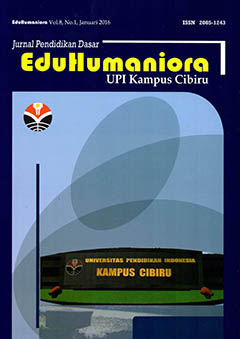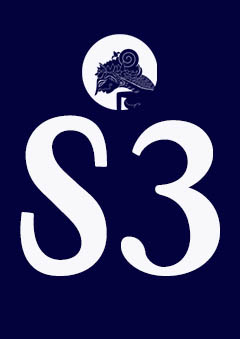DEVELOPING STUDENTS’ CRITICAL WRITING SKILLS OF ELEMENTARY SCHOOL BY USING VOCABULARY CHART
Abstract
Abstract:. This article is part of a classroom action research. The paper aims to describe how vocabulary chart is implemented in the writing learning process to develop elementary school students’ English as a Foreign Language (EFL) critical writing skills. The subject of the study is 28 primary school students grade 3 in one of the public schools in Bandung. The Classroom Action Research was employed in the study. The vocabulary chart was used in a 3-cycle lesson consisting of 9 meetings. This paper focuses on the implementation of vocabulary chart in the first cycle. This research is a qualitative research which used classroom observation, documentation, field note and student interview as the instrument of collecting data. After that the obtained data were discussed and processed to be described, analyzed, and reflected. The data that has been described is then analyzed to get the findings. In conclusion, the application of the vocabulary chart to develop elementary school students’ EFL critical writing skill can be implemented in two stages, namely: 1) the vocabulary chart delivery, and 2) the using of vocabulary chart in the students’ critical thinking. The study reveals that the vocabulary chart can develop elementary school students’ EFL critical writing skills.
Abstrak: Artikel ini adalah bagian dari penelitian tindakan kelas. Makalah ini bertujuan untuk menggambarkan bagaimana bagan kosakata diimplementasikan dalam proses pembelajaran menulis untuk mengembangkan kemampuan menulis kritis bahasa Inggris siswa sebagai Bahasa Asing (EFL). Subyek penelitian adalah 28 siswa sekolah dasar di kelas 3 di salah satu sekolah umum di Bandung. Penelitian Tindakan Kelas digunakan dalam penelitian ini. Bagan kosakata digunakan dalam pelajaran 3-siklus yang terdiri dari 9 pertemuan. Makalah ini berfokus pada penerapan grafik kosakata dalam siklus pertama. Penelitian ini merupakan penelitian kualitatif dengan observasi kelas, dokumentasi, catatan lapangan dan wawancara siswa. Setelah itu data didiskusikan dan diproses dengan cara yang dijelaskan, dianalisis, dan dipantulkan. Data yang telah dijelaskan dianalisis untuk melepaskan temuan. Dalam pengiriman grafik kosakata, dan 2) penggunaan grafik kosakata dalam pemikiran kritis siswa. Studi ini mengungkapkan bahwa grafik kosakata dapat mengembangkan keterampilan menulis kritis EFL siswa sekolah dasar.
Keywords
Full Text:
PDFReferences
Brewster, J., Ellis, G., & Girard, D., (2002). The primary English teacher's guide. London: Penguin.
Brien, L, T. (2013). The development of critical thinikng. Action research: develop critical thinking franklin fierce university, hlm. 1-16.
Carr & Kathryn. (1990). How can we teach critical thinking. ERIC clearinghouse on elementary and early childhood education urbana IL, hlm. 1-5.
Crystal, D. (2003). English is a global language. UK: Cambridge University Press.
Desmita. (2010). Psikologi Perkembangan. Bandung: Remaja Rosadakarya.
Donnely, H. & Linn, J. (2014). Critical thinking skills fire up teaching learning. Journal of Staff Development is the property of National Staff Development Council, 35 (2), hlm. 40-44.
Gebhard, J. G. (2006). Teaching English as a foreign language or second language: a teacher self-development ang methodology guide. USA: The University of Michigan Press.
Harmer, J. (2007). The practice of English language teaching-4th edition. London: Longman.
Kalantari, F. & Hashemian, M. (2016). A story-telling approach to teaching English to young EFL Iranian learners. Canadian Center of Science and Education, 9 (1), hlm. 221-234.
Kesuma, D. & Ibrahim, T. (2016). Struktur fundamental pedagogik. Bandung: Refika Aditama.
Komalasari, K. (2011). Pembelajaran kontekstual konsep dan aplikasi. Bandung: Refika Aditama.
Linse, C. T. (2005). Pratical English language teaching young learner. New York : McGraw Hill.
Merriam, S. B. (2002). Introduction to qualitative research. In S. B. Merriam (Ed.), Qualitative research in practice: Examples for discussion and analysis. San Francisco: Jossey-Bass.
Mooney, C. G. (2000). Theories of childhood. Manchester: Readleaf Press.
Peraturan Menteri Pendidikan dan Kebudayaan Republik Indonesia. (2014). Peraturan Menteri Pendidikan dan Kebudayaan Republik Indonesia Nomor 79 Tahun 2014 tentang Muatan Lokal Kurikulum 2013. [Online]. Diakses dari luk.staff.ugm.ac.id (27 Maret 2016).
Pinter, A. (2006). Teaching young language learner. New York : Cambridge University Press.
Schneider, V. (2002). Critical thinking in the elementary classroom: problems and solutions. Educators publishing service, hlm. 1-3.
Scott, A. W. & Ytreberg, H. L. (2003). Teaching English to children. New York: Longman.
Smith, H. C. S. (2013). Critical Writing. [Online]. Retrieved from www.eapfoundation.com/writing/critical (21 April 2016).
Sukarni (2012). English for Spesific Purposes, Indonesian Spesific Purposes, and Their Pragmatics Implications in Southeast Asia. Yogjakarta: Ombak.
Suyanto. (2009). English for Young Learners. Jakarta: Bumi Aksara.
Trilling, B & Fadel, S. (2009). 21st century skills. America: Jossey Bass A Wiley Imprint.
Winarno, B. & Suprana, J. (2001). Terampil berpikir. Jakarta: Milenia Populer.
DOI: https://doi.org/10.17509/eh.v10i2.10870
Refbacks
- There are currently no refbacks.
Copyright (c) 2018 EDUHUMANIORA: Jurnal Pendidikan Dasar
EduHumaniora: Jurnal Pendidikan Dasar
Published in collaboration Program Studi PGSD UPI Kampus Cibiru
and
HDPGSDI
This work is licensed under a Creative Commons Attribution-ShareAlike 4.0 International License.















